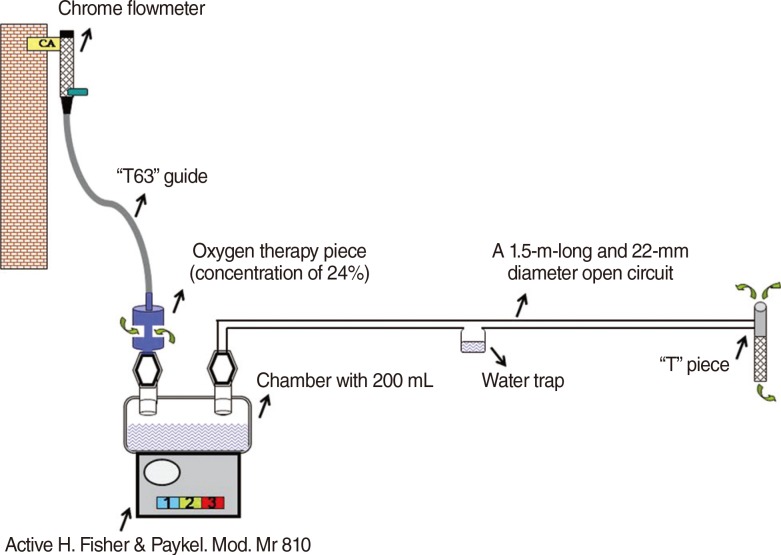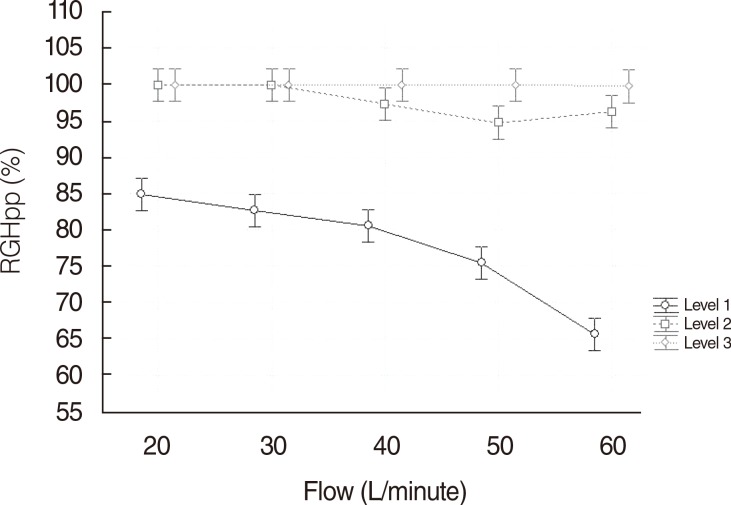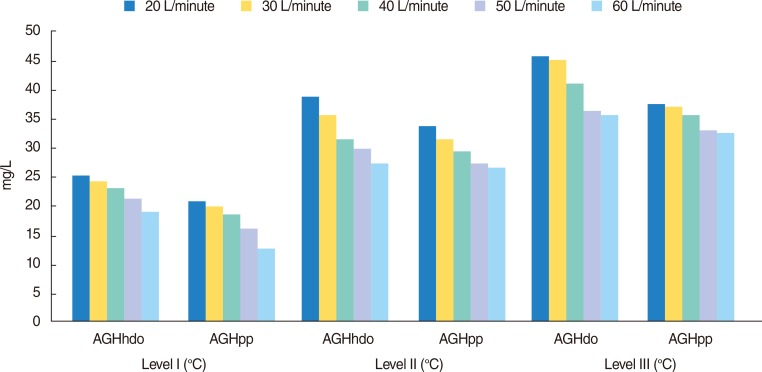Clin Exp Otorhinolaryngol.
2015 Mar;8(1):69-75. 10.3342/ceo.2015.8.1.69.
Evaluation of an Active Humidification System for Inspired Gas
- Affiliations
-
- 1Department of Respiratory Care, Clinica Basilea, Ciudad Autonoma de Buenos Aires, Argentina. gplotnikow@gmail.com
- 2Intensive Care Unit, Sanatorio Anchorena, Ciudad Autonoma de Buenos Aires, Argentina.
- KMID: 1973491
- DOI: http://doi.org/10.3342/ceo.2015.8.1.69
Abstract
OBJECTIVES
The effectiveness of the active humidification systems (AHS) in patients already weaned from mechanical ventilation and with an artificial airway has not been very well described. The objective of this study was to evaluate the performance of an AHS in chronically tracheostomized and spontaneously breathing patients.
METHODS
Measurements were quantified at three levels of temperature (Tdegrees) of the AHS: level I, low; level II, middle; and level III, high and at different flow levels (20 to 60 L/minute). Statistical analysis of repeated measurements was performed using analysis of variance and significance was set at a P<0.05.
RESULTS
While the lowest temperature setting (level I) did not condition gas to the minimum recommended values for any of the flows that were used, the medium temperature setting (level II) only conditioned gas with flows of 20 and 30 L/minute. Finally, at the highest temperature setting (level III), every flow reached the minimum absolute humidity (AH) recommended of 30 mg/L.
CONCLUSION
According to our results, to obtain appropiate relative humidity, AH and Tdegrees of gas one should have a device that maintains water Tdegrees at least at 53degrees C for flows between 20 and 30 L/m, or at Tdegrees of 61degrees C at any flow rate.
Keyword
MeSH Terms
Figure
Reference
-
1. Branson RD. Humidification for patients with artificial airways. Respir Care. 1999; 6. 44(6):630–641.2. Rathgeber J. Devices used to humidify respired gases. Respir Care Clin N Am. 2006; 6. 12(2):165–182. PMID: 16828689.3. Sottiaux TM. Consequences of under- and over-humidification. Respir Care Clin N Am. 2006; 6. 12(2):233–252. PMID: 16828692.4. American Association for Respiratory Care. AARC clinical practice guideline. Humidification during mechanical ventilation. Respir Care. 1992; 8. 37(8):887–890. PMID: 10145779.5. American Association for Respiratory Care. Consensus statement on the essentials of mechanical ventilators: 1992. Respir Care. 1992; 9. 37(9):1000–1008. PMID: 10145697.6. Hess DR, Branson RD. Humidification: humidifiers and nebulizers. In : Branson RD, Hess DR, Chatburn RL, editors. Respiratory care equipment. 2nd ed. Philadelphia: JB Lippincott;1999. p. 101–132.
Article7. Setten M, Rodrigues La Moglie R. Humidificación, calentamiento y aerosolización del aire inspirado en la ventilación mecánica. In : Ceraso DH, Chiappero GR, Maskin BC, editors. Terapia intensiva. 4th ed. Buenos Aires: Editorial Médica Panamericana;2007. p. 202–206.8. Ploysongsang Y, Branson RD, Rashkin MC, Hurst JM. Effect of flowrate and duration of use on the pressure drop across six artificial noses. Respir Care. 1989; 34(10):902–907.9. Nishimura M, Nishijima MK, Okada T, Taenaka N, Yoshiya I. Comparison of flow-resistive work load due to humidifying devices. Chest. 1990; 3. 97(3):600–604. PMID: 2306964.
Article10. Manthous CA, Schmidt GA. Resistive pressure of a condenser humidifier in mechanically ventilated patients. Crit Care Med. 1994; 11. 22(11):1792–1795. PMID: 7956283.
Article11. Chiaranda M, Verona L, Pinamonti O, Dominioni L, Minoja G, Conti G. Use of heat and moisture exchanging (HME) filters in mechanically ventilated ICU patients: influence on airway flow-resistance. Intensive Care Med. 1993; 19(8):462–466. PMID: 8294629.
Article12. Iotti GA, Olivei MC, Palo A, Galbusera C, Veronesi R, Comelli A, et al. Unfavorable mechanical effects of heat and moisture exchangers in ventilated patients. Intensive Care Med. 1997; 4. 23(4):399–405. PMID: 9142578.13. Pelosi P, Solca M, Ravagnan I, Tubiolo D, Ferrario L, Gattinoni L. Effects of heat and moisture exchangers on minute ventilation, ventilatory drive, and work of breathing during pressure-support ventilation in acute respiratory failure. Crit Care Med. 1996; 7. 24(7):1184–1188. PMID: 8674333.
Article14. Conti G, De Blasi RA, Rocco M, Pelaia P, Antonelli M, Bufi M, et al. Effects of the heat-moisture exchangers on dynamic hyperinflation of mechanically ventilated COPD patients. Intensive Care Med. 1990; 16(7):441–443. PMID: 2269712.
Article15. Le Bourdellès G, Mier L, Fiquet B, Djedaini K, Saumon G, Coste F, et al. Comparison of the effects of heat and moisture exchangers and heated humidifiers on ventilation and gas exchange during weaning trials from mechanical ventilation. Chest. 1996; 11. 110(5):1294–1298. PMID: 8915237.
Article16. Branson RD, Davis K Jr, Campbell RS, Johnson DJ, Porembka DT. Humidification in the intensive care unit. Prospective study of a new protocol utilizing heated humidification and a hygroscopic condenser humidifier. Chest. 1993; 12. 104(6):1800–1805. PMID: 8252968.17. Chanques G, Constantin JM, Sauter M, Jung B, Sebbane M, Verzilli D, et al. Discomfort associated with underhumidified high-flow oxygen therapy in critically ill patients. Intensive Care Med. 2009; 6. 35(6):996–1003. PMID: 19294365.
Article18. Scanlan CL. Physical principles in respiratory care. In : Scanlan CL, Wilkins RL, Stoller JK, editors. Egan's fundamentals of respiratory care. 7th ed. St. Louis, MO: Mosby;1999. p. 79–107.
Article
- Full Text Links
- Actions
-
Cited
- CITED
-
- Close
- Share
- Similar articles
-
- Effects of Six Heat and Miosture Exchange for Use during Endotracheal Anesthesia
- Change of inspired oxygen concentration in low flow anesthesia
- Humidity of Inspired Gases in Partial Rebreathing Anesthesia Method with and without Bird Humidifier
- Uptake of Inhalation Anesthetics at the Different Inflow Rate in Semiclosed Circuit
- Effects of Fresh Gas Flow Rate on the Ratio of Expired to Inspired Anesthetic Concentration




